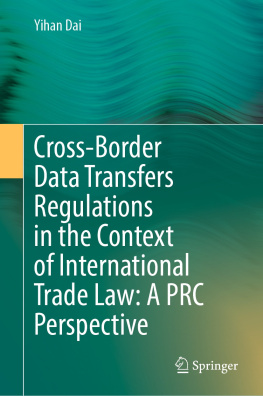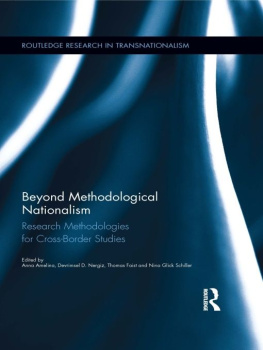
CROSS-BORDER COLLABORATIVE JOURNALISM
Cross-Border Collaborative Journalism is a detailed guide to transnational reporting, a cutting-edge journalistic strategy. In the twenty-first century, the most pressing political and social issues, such as financial crises, wealth inequality, migration flows and environmental collapse, transcend national borders. In reaction, journalists are increasingly collaborating across the globe to produce impactful and in-depth reporting. Recent agenda-setting cross-border collaborations include LuxLeaks, Panama Papers and Football Leaks.
Brigitte Alfter takes the reader, step-by-step, through the history of cross-border collaborative journalism and the current working practices behind it. The book draws from the authors own experience, as well as exclusive interviews with other pioneers of cross-border journalism, and notable cases are integrated throughout.
Chapters cover:
Managing intercultural communication
Effectively utilising a network of sources
Choosing the initial story idea
Fact-checking for cross-border publication
Adapting the findings to different audiences and to different types of media
Legal and security considerations for a cross-border team.
By providing the essential practical skills for transnational reporting, Cross-Border Collaborative Journalism encourages students of journalism and practitioners to undertake their own collaborative projects. It highlights the importance of this exciting new journalistic form to answering the defining questions of our time.
Brigitte Alfter is an award-winning German-Danish journalist. She practised journalism at local, national and European level before setting up European support structures for cross-border journalism. Today she combines journalism practice, journalism networking and academic research.
CROSS-BORDER
COLLABORATIVE
JOURNALISM
A Step-By-Step Guide
Brigitte Alfter
First published 2019
by Routledge
2 Park Square, Milton Park, Abingdon, Oxon OX14 4RN
and by Routledge
52 Vanderbilt Avenue, New York, NY 10017
Routledge is an imprint of the Taylor & Francis Group, an informa business
2019 Brigitte Alfter
The right of Brigitte Alfter to be identified as author of this work has been asserted by her in accordance with sections 77 and 78 of the Copyright, Designs and Patents Act 1988.
All rights reserved. No part of this book may be reprinted or reproduced or utilised in any form or by any electronic, mechanical, or other means, now known or hereafter invented, including photocopying and recording, or in any information storage or retrieval system, without permission in writing from the publishers.
Trademark notice : Product or corporate names may be trademarks or registered trademarks, and are used only for identification and explanation without intent to infringe.
British Library Cataloguing-in-Publication Data
A catalogue record for this book is available from the British Library
Library of Congress Cataloging-in-Publication Data
Names: Alfter, Brigitte, 1966- author.
Title: Cross-border collaborative journalism : a step-by-step guide / Brigitte Alfter.
Description: London ; New York : Routledge, 2019. | Includes bibliographical references.
Identifiers: LCCN 2018050744| ISBN 9781138613614 (hardback : alk. paper) | ISBN 9781138613638 (paperback : alk. paper) | ISBN 9780429464409 (ebook)
Subjects: LCSH: Investigative reporting. | Foreign correspondents. | Foreign news.
Classification: LCC PN4781 .A525 2019 | DDC 070.4/3dc23
LC record available at https://lccn.loc.gov/2018050744
ISBN: 978-1-138-61361-4 (hbk)
ISBN: 978-1-138-61363-8 (pbk)
ISBN: 978-0-429-46440-9 (ebk)
Typeset in Bembo
by Swales & Willis Ltd, Exeter, Devon, UK
In 2005, as an EU correspondent in Brussels for the Danish daily newspaper Information , I realised that I needed to collaborate with colleagues in other EU countries. Only if I made this extra effort could I obtain the information I needed to properly serve my readers in Denmark to bring them a little closer to the whole picture instead of them seeing just a fraction of our European reality. My efforts to collaborate were need-driven, and I thus came to be among the early practitioners of cross-border collaborative journalism in Europe.
Soon I realised that there was a need to analyse cross-border collaborative journalism as a distinct work process. This would provide a more thorough understanding of the individual steps involved. The cross-border pathway travels from story idea to teamwork to publication and onward to networking for the next story. A step-by-step approach has allowed me as a professional to improve my practice not least by learning from other professions and from scholars. The step-by-step pathway also allows us to share our experiences between peers in a better way. Students of journalism can get acquainted with the individual steps; senior practitioners can enrich aspects of each step with their insights; and scholars can contribute to a better understanding of the steps with an analytical and interdisciplinary approach.
That was exactly what started to happen once an earlier version of this book was published in Danish (2015) and German (2017) and the step-by-step pathway was also summarised in English (2016). Practitioners and scholars began to contribute new analysis of great use for cross-border journalism, and it has been possible to include some of these most recent developments in the present and largely rewritten English version. As the techniques of cross-border collaboration become more established, practitioners have started to address new aspects of the process we could call them general or editorial aspects such as the coordination of cross-border collaboration (Alfter, 2018); legal and technology issues; and attempts to understand the nature and functions of network structures.
Since 2010, and particularly since the publication of large and very prominent cross-border projects such as the WikiLeaks cables, the Panama Papers and Football Leaks, interest in cross-border collaborative journalism has grown among journalists, journalism schools, scholars and indeed publishers. Some even call cross-border collaboration a mere current buzzword, but on that I disagree. I think cross-border journalism is the best method so far developed within the profession of journalism to address the global challenges that all our societies are facing. These are challenges that materialise in very different ways throughout the world and that must be addressed in very different ways. In networked societies we must realise that there is no one-size-fits-all but a need to develop ways of working together with mutual respect for different traditions of journalism. Otherwise we cannot reach out to the vast variety of citizens we are serving.
The mountain of distance might at first seem insurmountable between a young journalist straight out of journalism school and the Pulitzer-Award winning global teams whose cross-border publications have been such journalistic game-changers. Experience shows: it is not. Cross-border collaborative journalism is simply a method: the necessary skills can be learnt. Anecdotal evidence is easily available and it offers several examples where students of journalism have prepared a cross-border investigation as part of their studies and followed it up in the first steps of their professional career. It is my hope that this book encourages journalists and students of journalism alike to acquire a global outlook and to practise cross-border collaborative journalism.








